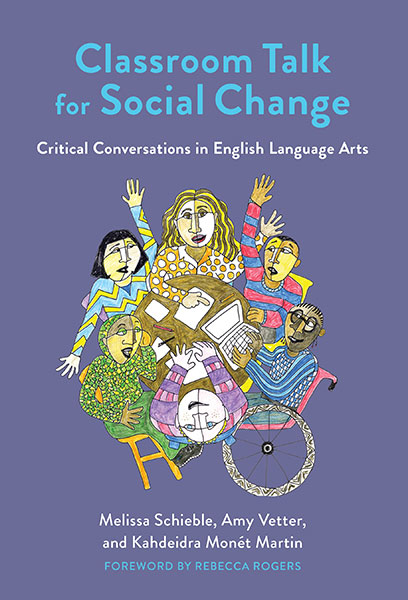Classroom Talk for Social Change
Melissa Schieble, Amy Vetter, and Kahdeidra Monét Martin
Publication Date: February 14, 2020
Pages: 160
Classroom Talk for Social Change tackles pedagogies of classroom discourse surrounding thorny issues that create tension and anxiety for teachers and students alike. Written for classroom teachers, the work is divided into eight accessible chapters that provide theory, research, key terms, and firsthand narratives. Additionally, each chapter contains reflective questions for personal or group use and a well-curated list of topical readings focusing on power, culturally sustaining pedagogies, and teacher talk. Though there are many books about classroom discussion, this carefully researched volume is an invaluable go-to guide for teachers eager to address critical conversations responsibly.
While the initial chapters lay the groundwork for discussions of power, privilege, reflection, and racial literacy, Chapter 4 provides methods of establishing a critical learner stance or a “mindset that embraces the possibility for challenging, rethinking, or developing nuanced understandings about knowledge” (p. 14). Through engaging in self-reflection, teachers can best prepare for conversations about confronting power and more ably guide students to examine white privilege and dominant, oppressive narratives related to gender or class.
In Chapter 5, the authors examine discourse spaces that encourage a more equitable flow of ideas, habits of critical listening, and lines of questioning and response. The chapter’s focus on vulnerability and discomfort gives weight to affective responses in complex discussions, and the authors provide a thoughtful, stepped approach to navigate “tension and model repair” (p.66). Since reparative work seems uncommon (or absent) on social media platforms, the authors include verbal and written cues to enable students to identify their feelings and respond to complex topics. At the same time, they encourage teachers to join in critical conversations through collegial affinity groups to reveal bias, combat prejudice, and disrupt beliefs.
A trio of chapters then provides additional methods of practice and reflection for critical conversations. Chapter 6 provides teachers with varied tools to navigate critical conversations about race, gender, and sexuality. First, the authors offer protocols to humanize discussion—to de-essentialize ideas, encourage mindful language, and listen critically to others. Second, they name methods for teachers to address racist, sexist, homophobic, and transphobic discourse and invite the class to name how identity politics (e.g., focused on race, class, gender, or sexual orientation) can shape ideas and events, interrupt existing power structures, surface systemic oppression, and strategize ways to combat such systems in support of equity. Chapter 7 examines how four teachers’ talk moves—those that pose essential questions, disrupt status quo mindsets, render discourse more inclusive, and facilitate gateways to civic action—form the basis of critical conversations. Last, Chapter 8 invites teachers to consider how collegial inquiry groups afford teachers a safe space to reflect on critical classroom conversations. This chapter provides a practitioner model for inquiry groups, based on the authors’ experience of recording and transcribing conversations, identifying each teacher’s reflexive position in discussion, and breaking down the spoken, unspoken, and unremarked that can occur with complex conversations.
This work’s great strength is how it balances the context of critical conversations with a practical guide for teachers before entering classroom discussions about race, gender, sexuality, and ability. As a former secondary school teacher, I have observed how easily classroom conversations can diffuse into vague abstractions or sharpen regrettably into personal attacks. As a college professor, I notice students retreating from controversial topics into the dangerous safety of neutrality. Thankfully, these authors encourage teachers to engage, rather than retreat, from critical discourse—to create safe spaces of discourse, articulate ground rules, and practice inquiry and disruption, rather than battle in debate and defense. By doing so, they provide what many teachers have yearned for amid the sound and fury: an equitable and mindful framework for classroom discussion on topics relevant to the lives of our students.
Read the full review at English Education

